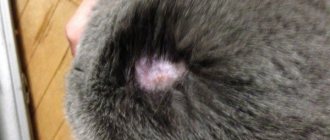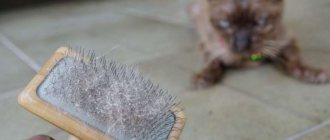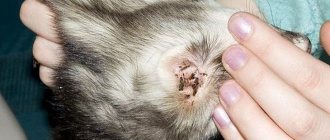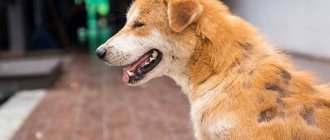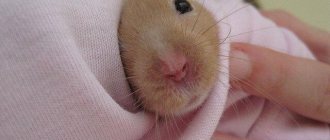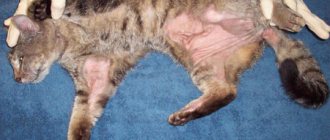Why does a cat have bald spots?
There are many possible reasons why your cat may be losing hair. Some of these may be due to external factors, while others may be a sign that your cat has a medical condition that requires treatment.
Most often, bald spots in cats can be associated with one of the following reasons:
- Fleas or other parasites
- Ringworm
- Stress
- Allergies
- Cancer
© shutterstock
Tail gland hyperplasia
If the tail gland has increased hyperplasia, excessive accumulation of sebaceous secretion appears. It is released and envelops the hair at the point of growth, blocking its further development. Because of this, her hair falls out and areas of baldness appear.
Therapy involves monitoring the problem area. Castration can help cats.
How to treat bald spots on a cat?
The treatment needed depends on what caused the bald spots in the first place. Unfortunately, there is no one-size-fits-all cure that will help your cat regrow hair, regardless of the cause of its hair loss. For example, treating a cat that is highly stressed is very different from treating a cat that has fleas.
That's why when you notice bald spots, the first step should always be to determine the cause of the problem. Each of the sections below focuses on one of these underlying causes to help you determine what is bothering your kitten. We will also share some possible remedies. As always, if you have any questions or need further support, be sure to contact your cat's veterinarian!
Description of the problem
The structure of cat hair is not similar to human hair. Unlike humans, most cats do not tend to go bald as they grow older. Despite periodic molting, they retain dense vegetation on their body even in old age. That is why the appearance of bald spots is always considered a pathology.
The exception is hairless cat breeds. In these pets, the lack of hair on the body is a congenital feature.
Intense hair loss (alopecia) occurs in different areas of the body or can be symmetrical. The following areas are predominantly deprived of vegetation:
- stomach;
- back;
- lateral areas of the body;
- hips;
- hind legs;
- tail part.
Baldness in animals can be partial or complete. Most often, hair is lost during illness or as a result of reactions to negative stimuli. In some situations, a cat goes bald due to natural processes in the body.
In the presence of unfavorable factors, baldness can develop in both males and females. Most often, this pathology is observed in mature individuals and extremely rarely affects kittens.
Fleas and other parasites
Fleas are one of the most common causes of bald spots in cats. When cats have fleas or other parasites such as ticks or lice, they may scratch or lick their fur to try to get rid of the itchy sensation they experience. However, excessive grooming and scratching is not the only problem! Some cats have allergic reactions to flea saliva, resulting in visible bald spots and irritated patches of skin - usually on the face or neck. Interestingly, this allergic reaction occurs within 14 days of the fleas being gone.
What are the signs that a cat has fleas?
In addition to hair loss, you may also notice adult fleas jumping or moving around your cat's fur. However, adult fleas are not always easy to spot because they move so quickly. Don't rule out that your cat has fleas just because you don't see fleas on them.
Another thing you may find is flea dirt on your cat's fur. Flea dirt, which is flea feces. They usually look like small specks of pepper, but will turn rusty red when rubbed with water.
What should I do if my cat has fleas?
If your cat has fleas, you can treat them just as well as at home. Karen Hiestand explains that you need to treat fleas at all stages of their life cycle to completely eliminate the threat. Each flea lays 50 eggs every day, so it's easy to see how quickly a flea problem can get out of control.
When choosing a flea treatment for your cat, seek appropriate and recommended treatment from your veterinarian. This ensures that the product is safe and effective for your cat.
In addition to treating your cat, you will also need to treat your home to remove any flea eggs or larvae that may have fallen from your cat. There are environmental sprays designed for this purpose. Your veterinarian is also a good source for a safe and reliable product.
Subcutaneous mite
This parasite causes demodicosis. Damage is caused to both the animal's fur and its skin. There is no consensus yet on how exactly an animal becomes infected. Some suggest that the pet becomes infected from another sick animal. Others think that ticks are on the cat all the time, but only when its body weakens do they begin their destructive effect. The main sign that the parasite is active is hair loss. The lesions are located on the ears, eyebrows, near the mouth and nose, and the paws also suffer. Baldness gradually becomes more noticeable, and dermatitis appears.
Ringworm
Ringworm may be another possible cause of bald spots on your cat. It is more common in kittens or long-haired cats, although older or short-haired cats can still become infected. If your cat has lost hair due to ringworm, you will probably notice that the area of hair loss is rounded.
If you suspect that ringworm may be causing your cat's hair loss, you may want to take it to your veterinarian. They may do a fungal culture or skin biopsy to confirm if your cat has ringworm.
© shutterstock
How can you tell if your cat has ringworm?
You may notice some additional symptoms of ringworm outside of the circular or patchy area of hair loss. These may include dandruff on your cat's fur, dark, red or irritated skin, increased scratching due to itching, and round or oozing lesions on your cat's skin.
Typical symptoms
Signs of developing alopecia are easy to detect even without veterinary education. The first symptom is thinning hair on the sides of the body, behind the ears, and in the tail area. Progressive pathology provokes the appearance of other characteristic signs:
- hair loss in large clumps;
- exposing areas of skin that acquire a pink or reddish tint;
- formation of unsightly crusts in areas affected by alopecia.
If your cat is going bald due to a serious medical condition, sores, scabs, or whitish bumps may form in the problem areas. The skin in the bald area sometimes becomes hot and loses its natural elasticity.
Many cats with alopecia become restless, experience constant discomfort, and avoid contact with their owners in every possible way. A cat may constantly lick and scratch hairless areas of the body, further injuring them.
With Itsenko-Cushing's disease, which affects cats in isolated cases, the animals not only go bald. Other symptoms are also observed - increased hunger and thirst, an increase in the size of the abdomen, and thinning of the epidermis.
Stress
Stress in cats can manifest itself in a number of ways, one of which is hair loss. Cats that are stressed may begin to scratch or lick their fur compulsively. This is called psychogenic alopecia.
Can cats get bald spots from stress?
Yes, excessive licking due to psychogenic alopecia can cause bald spots. This disease is most common in purebred cats, although these are not the only cats that can be affected.
If you suspect stress is causing your cat's hair loss, you can try environmental changes to relieve her stress. These changes may include separating your cat from other pets that may contribute to stress, providing extra attention, or installing a cat tree to give her a safe place to retreat.
Some cats may also require medications to reduce stress and anxiety. If you think this is the case, talk to your veterinarian to get his thoughts and recommendations.
Acne
Acne can appear due to improper care of your pet, severe stress and emotional distress. Acne can develop into pustules and ulcers, which cause severe pain for your pet and sometimes lead to inflammation.
A complication of acne is folliculitis. It is a swelling around the hair, usually with liquid contents. When touched, the pet experiences pain.
Self-medication and squeezing pimples are not recommended. You can treat rashes with tar soap or shampoo.
Allergies
Allergies are the most common cause of bald spots; it causes cats to itch severely and start licking their fur. Over time, this excessive licking can lead to bald spots.
If your cat has an allergy, it can be caused by a variety of factors. Some cats may be allergic to something in their environment, such as dust or insect bites. These cats may require medication to treat allergies.
Other cats may have allergies to food or medications they take. Once you determine the cause of their allergies, you can change their food or medications and may not need treatment.
Dietary rules for those who do not require treatment
Good nutrition is of particular importance for maintaining a well-groomed appearance. You cannot feed your cat from your table. Your daily diet should contain proteins and vitamins.
When feeding natural foods, it is necessary to include meat as a source of protein and fish (omega-3 fatty acids). They are responsible for the healthy appearance of fur. Vegetables, herbs, and seafood are good for cats.
Sour milk improves the absorption of vitamins and has a good effect on the health of the coat.
If the cause of alopecia is a food allergy or lack of vitamins and minerals, you should carefully review your pet's diet. Only foods of at least premium, super premium and holistic classes have a balanced composition containing all the necessary nutrients, vitamins and amino acids.
Cancer
Although it is quite rare, cancer may be the cause of your cat's hair loss. Paraneoplastic alopecia in cats may be a sign of pancreatic cancer. Cats with this condition may shed, scratch, or groom themselves more often.
It is also possible that you will notice cracks in your cat's paw pads. Weight loss and decreased appetite are also symptoms to watch for in cats with feline paraneoplastic alopecia. If you notice any of these symptoms, you should schedule a visit with your veterinarian right away.
Eczema
Eczema is an unpredictable disease.
Appears due to many factors, including:
- Severe skin contamination with parasites, dirt, bacteria;
- Improper wearing of collars and synthetic clothing for cats;
- Complication of any disease (pathology of the nervous system, kidney disease, stomach and liver).
The main symptom is a weeping surface of the skin. Scratching causes knots and redness to form. The cat is rapidly losing weight, has a fever and kidney problems.
For diagnostic purposes, the veterinarian will take a skin scraping to rule out the possibility of other diseases. Afterwards he should prescribe antihistamines. You should not try to treat your cat without a doctor, as complications may develop.
